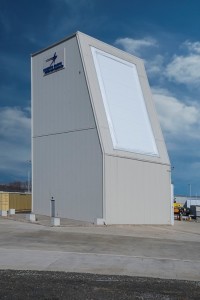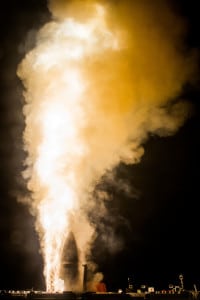Last month, the Missile Defense Agency (MDA), U.S. Navy, and Japanese government verified a third successful demonstration of software allowing Japan to use the SPY-7 radar on an Aegis-capable ship for missile defense uses.
MDA, the Navy Aegis Technical Representative and Japan Maritime Self-Defense Force on Aug. 10 witnessed a third successful demonstration of the J7.B Japanese variant of the Aegis software build in support of the Japan Aegis System-Equipped Vessel (ASEV) program), the agency said on Sept. 13.

The agency said that this demonstration was called ASEV Software Release 3 and seeks to allow Japan to field the software and Lockheed Martin [LMT] SPY-7(V)1 radar onboard Japanese Aegis-capable ships “ to provide ballistic missile defense (BMD) of the Japanese homeland.”
“MDA has confirmed Aegis Baseline J7.B hardware and software can command and control the SPY-7(V)1 radar, demonstrating all the major BMD capabilities required for the Japanese ASEV,” MDA Director Vice Adm. Jon Hill said in a statement.
“This is another vital milestone in development and integration efforts. The overall ASEV J7.B with SPY-7 effort remains on track for meeting cost, schedule, and performance criteria. This program will provide Japan with the latest BMD capabilities, which will undoubtedly contribute to the defense of Japan under the increasing regional missile threats,” he added.
The last demonstration, ASEV Software Release 2, occurred in January 2022, which MDA said showed the software has the capability to engage enemy ballistic missiles using the Standard Missile-3 Block IIA missile, a cooperatively-developed project between the U.S. and Japan.
MDA said beyond the work demonstrated in Release 2, Release 3 exercised the complete ballistic missile defense fire control loop and functions, validating the program is proceeding on schedule “with a majority of development work now complete.”
The agency specifically said that Release 3 demonstrated the J7.B software and hardware proved functional control of the SPY-7 radar, including Engage on Remote function and large-raid engagement.
MDA and the Navy witnessed the first successful demonstration of theJ7.B software baseline in early 2021. That demonstration showed the software working with a SPY-7 radar at Lockheed Martin’s facility in Moorestown, N.J. (Defense Daily, Feb. 26, 2021).
At the time, the agency said the Japanese software baseline was equivalent to the Navy’s Aegis Baseline 9 with integrated air and missile defense used on Arleigh Burke-class destroyers and Aegis Ashore sites.
MDA noted Baseline J7.B adds the solid-state SPY-7 radar and was set to use the latest capabilities and functionality from Aegis Baseline 9 and Baseline 10 available in the Aegis Common Source Library.

This is an outgrowth of Japan’s decision to cancel plans to use the Lockheed Martin Long Range Discrimination Radar (LRDR) for two Aegis Ashore sites. The country scrapped the plans in 2020 due to technical and cost concerns (Defense Daily, June 29, 2020).
Japan then said it was redirecting to focus on adding to its sea-based Aegis missile defense capabilities.
The SPY-7 S-band gallium-nitride-based radar is derived from the LRDR, first procured by MDA for use at Clear Space Force Station in Clear, Alaska. The LRDR is being used by MDA to improve the Ground-based Midcourse Defense system’s ability to track ballistic missile threats to the U.S.
After the initial 2021 test, MDA said when the baseline J7.B system was completed MDA and the Navy’s Navy Aegis Technical Representative would test it with four production-version SPY-7 radar arrays with live ballistic missile target tracking exercises at the Aegis production Test Center, which has helped test and certify Aegis radars for over 40 years.